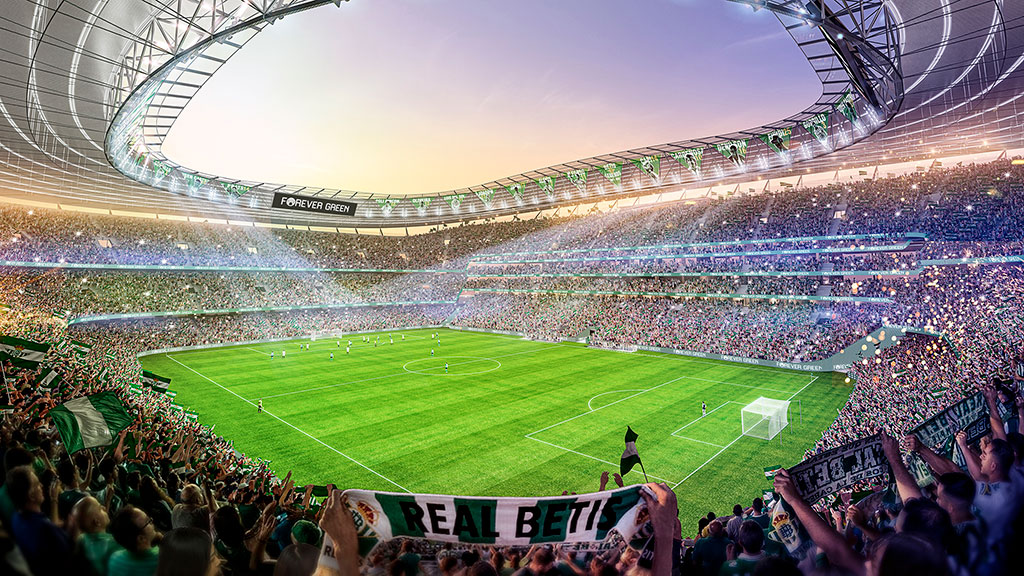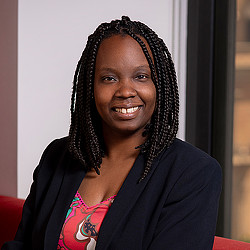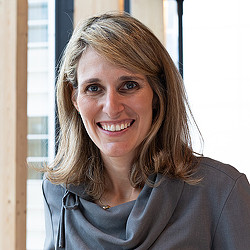Trends Shaping Sports Venue Design in the European Market
March 28, 2024 | Q&A with Demetra Thornton and Tayomara Gama
Editor’s Note: This blog is part of our Design Forecast blog series, looking at what’s next in 2024 and beyond.
This summer, Europe will be a hotbed for major sports events with the 2024 Olympic Summer Games in Paris, Wimbledon 2024 in the U.K., and the 2024 UEFA European Football Championships in Germany, among others.
In this Q&A, Demetra Thornton, co-managing director of Gensler’s Raleigh-Durham office and formerly Managing Director and Sports Studio Director in Gensler’s Los Angeles office, sat down with Tayomara Gama, Sports leader for Gensler Europe, to discuss what’s next for stadium and training facilities in Europe, and key opportunities for growth in the European market.
Demetra Thornton: Tell us about your background. How did you get started in architecture?
Tayomara Gama: From a very early age, before even knowing that architecture was a profession, I enjoyed space planning and sketching the streets. As a child, I was drawn to the beauty of Ibirapuera Park in São Paulo, by architect Oscar Niemeyer, and we frequently visited Morumbi Stadium, by Vilanova Artigas. My family’s love for football and my grandfather’s experiences during the 1990 World Cup in Italy further powered my interest in architecture design for crowds.
Later, I applied to Escola da Cidade in São Paulo, a design-focused school for architecture and urban planning. Surrounded by influential figures, I found myself in an environment that embraced provocation, which I truly enjoyed. During my fourth academic year, a professor recommended me for an internship at Jorge Wilheim Studio, a transformative experience where I compiled 50 years of his work used in the Biennale.
I continued my architectural pursuits through global urban explorations — from Millennium Park in Chicago to the Guggenheim Museum in New York to the monumentality that the Olimpiastadion gives to Berlin. I applied for an internship in Budapest through the International Association for the Exchange of Students for Technical Experience, a global non-governmental organization. This experience introduced me to new technologies in design and modeling, while giving me the opportunity to explore a continent alongside architecture students from around the world. Notably, one of these connections led me to work for the 2016 Summer Olympics in Rio de Janeiro.
DT: What’s your favorite sports project that integrates arena, stadium, and urban planning?
TG: I find myself drawn to monumental projects where major infrastructure can have a profound impact. Working on sports venues aligns seamlessly with this ambition, as these structures possess a unique capacity to instigate positive change in overlooked or vacant areas.
I’m inspired by the simplicity of ideas from the Bauhaus movement and the principle of good design for all. I like the idea of creating functional yet remarkable “big infrastructure” —monumental constructions that not only serve immediate purposes but also act as potent catalysts for positive change. These projects leave a lasting impact on their surroundings and on those fortunate enough to experience them because they’re innovative, functional, and visually appealing. The sports projects I love are usually acting as centrepiece, attracting visitors, and at same time contributing to overall growth of their neighbourhood or region.
DT: Tell us about your favorite project that you’ve designed.
TG: Each project I’ve contributed to holds a special place in my journey. Before joining Gensler, I worked on the new stadium for Everton at Bromley Moore Dock along the River Mersey. Working within the context of European football and British regulations, my role in project and design management allowed me to oversee the harmonious integration of brick, glass, and steel, creating a vibrant and state-of-the-art sports arena that redefines stadia design.
I was also involved in two stadia projects for the 2022 World Cup in Qatar. These required extensive infrastructure development, the client wanted them to have a significant social impact, particularly in the case of the Education City Stadium. The venue is positioned as a destination dedicated to women’s and girls’ engagement, emphasizing education, health, and well-being within the Qatar Foundation university campus.
The Rio Olympics was an amazing challenge. I served as venue architect for the National Shooting Centre, and later project manager for the extreme sports park, including the Whitewater Stadium and the BMX Centre. Today, the park still serves athletes, but it has also become a local community center.
DT: What does state-of-the-art facility mean to you?
TG: To me, a state-of-the-art facility represents the apogee of design, functionality, and innovation, while understanding the geographical context. Collaboration is crucial for going beyond conventional technological integration and setting new standards for design excellence, including the incorporation of local technologies and construction methods.
In the context of sports projects, we’re designing for things like player safety, optimal playing conditions, and adaptability to various sports in addition using the latest advancements in turf technology.
In my opinion, the field of play is the heart of a sport facility and the bowl its soul. When we go beyond providing basic amenities — when we blend innovative design, ergonomic considerations, and the integration of smart technologies to enhance the spectator experience — this is top-notch design.
By embodying a harmonious blend of aesthetic appeal and environmental consciousness, these facilities contribute to the creation of a lasting impact on both the immediate surroundings and the communities they serve. In essence, a state-of-the-art facility pushes the boundaries of what is possible, whilst setting a benchmark for excellence in every aspect, including the pitch, the seating, and the project’s overall architectural and technological integration.
DT: As the sports leader in Europe, what are some growth opportunities for the sports practice in your region?
TG: There are various growth opportunities for our sports practice in Europe. One is around the rejuvenation of outdated and underinvested sports venues, stadia, and arenas. Another opportunity is supporting the (re)development of training grounds, which play a crucial role for athletes’ performance. Clubs in Europe are rethinking the accommodations to be more equitable for men’s and women’s teams, for both academy and staff.
Another notable trend is the development of sports-anchored districts, which presents a significant avenue for expansion. One example is Queen Elizabeth Olympic Park, which was built for the 2012 Summer Olympics, regenerating Stratford as a new postcode for London. This stands in contrast to what’s being done for the 2024 Summer Olympic Games in Paris, which is instead using the whole city of Paris as the backdrop for the event. Both approach the same goal of creating long-term benefits for the host city, its people, and the Olympic Movement before, during, and long after the Olympic Games in a manner that fits their particular needs.
We’re learning a lot from these types of integrated mixed-use developments in the U.S., and it can help us transform European sports venues into dynamic hubs that have more of a lifestyle ecosystem around the games, fostering a balanced live-work-play environment, while also supporting healthier habits and well-being.
There is substantial potential in optimizing the year-round operational efficiency of European venues. Addressing community constraints such as traffic and transportation not only enhances the accessibility of these venues but also serves as a catalyst for unlocking previously untapped revenue streams for our clients. By incorporating branding and entertainment elements, we can create a holistic and immersive experience, further enriching the overall appeal and economic viability of these spaces. This comprehensive and integrated approach resonates with the evolving needs and expectations of our communities and clients in this region.
DT: Is there anything going on around the globe in sports that’s changing your view on sports design?
TG: Sports design is ever-changing. Things like street sports, smart venues, and branding are increasingly shaping the look and feel of a place. The rise of e-sports is another emerging trend, and we need to think about how we are conceptualizing these venues. And then, you have new Olympic sports like BMX freestyle, skateboarding, and climbing. How can we create dynamic spaces that allow new generations to use them. And smart venues are incorporating cutting-edge technologies to enhance the fan experience. Everybody engages with a mobile phone now, so there’s data that can help us better shape design and operations.
DT: In the U.S., we’re seeing a lot more women’s professional teams and women founders and owners of teams. Are you seeing similar things in Europe?
TG: We are seeing a lot more women’s teams, owners, and founders, but there’s all the “in-between” that also needs addressing. Yes, there’s a significant development occurring in the landscape of women’s professional sports teams, like what we’re observing in the U.S., but there’s all the “in-between” that also needs addressing. We need more women entering boardrooms and management roles to really mark a shift in the mentality towards inclusivity and diversity.
It is difficult to compare the U.S. and Europe but using football as a comparison due to its popularity in the continent, there’s a distinction. In the U.S., women’s clubs operate independently, whereas in Europe, women’s teams often function as extensions of men’s teams, with varying levels of investment and support. We do have examples like Lewes Football Club’s decision in 2017 to equally split revenue — that was groundbreaking, demonstrating potential for more equitable treatment.
Globally, since women started occupying executive positions, we have started addressing the gaps in women’s sports infrastructure. This includes tailored equipment, improved training facilities, and venues that can accommodate the unique atmosphere of women’s sporting events.
Indeed, there’s undeniable progress, and we will see the first Olympics with a 50/50 split of male and female competitors in Paris this year. But due to lower revenues and sponsorships compared to men’s teams, achieving financial sustainability remains a challenge.
DT: What are you most excited about as you look to the future for our sports practice?
TG: Being part of a borderless community really excites me. I love Gensler’s One-Firm Firm approach. Collaborating with offices worldwide and fostering strategic partnerships, we are actively working towards building a diverse and inclusive community that transcends geographical boundaries. I am eager to witness the transformative impact of our projects on the future of this region, with a keen focus on ensuring that our teams reflect the diversity and equality we champion.
For media inquiries, email .


